Some days I wake up, get dressed, and take several moments to look at myself in the mirror.
"I'm fat."
This is something I say to myself or some rendition of it, and other days it hurts more than others. Some days it's a call to something I wish I wasn't. Other days, it's just me observing the space I occupy.
I often times make these comments around my friends. "Brittany, don't say that! You're not fat!"
But, what if I am? What would be wrong with that? What is wrong with using that word?
I call this interaction fatphobia. Fatphobia is defined as the pathological fear of fatness often manifested as negative attitude and stereotypes about
fat people. Fatphobia is essentially stitched into our
American culture, has become so embedded into our lives that it has become hard to recognize when we are even exhibiting fatphobia, much like my personal example before. Currently, Michigan is the only state that currently has a law in place that forbids employers from penalizing fat people in the work place, which means the other 49 states have the ability to fire, deny promotions, or pay their fatter workers less. A 2017 survey found that many hiring managers tend to associate fatness with laziness, and are therefore less likely to hire a fat individual over their thin counterpart. Additionally, a separate survey done by primary care physicians found that they often view obese patients as awkward, unattractive, and noncompliant.
Doctor Lilia Graue reported, "Doctors often fail to provide adequate and timely diagnosis and treatment due to obese and overweight assumptions."
This assumption almost lost one individual their life.
In 2018, Rebecca Hiles came forth and told her story of how she had coughing fits for years to the point it caused severe muscle spasms. Doctors repeated told her her symptoms would disappear if she lost weight, until one day her coughs were so severe she ended up in the ER diagnosed with a tumor on her bronchial tube resulting in the removal of an entire lung. If doctors hadn't focused so much on her weight, maybe this could have been preventable. This is a prime example why fatphobia needs to end, and instead should be transitioned into something more accepting of all body types.
Body positivity has become quite a mainstream term across social media. Many body posts now a days will feature the hashtag #bodypositivity. Many individuals have confirmed that this movement has indeed changed body outlooks, which is great! It's creating a change in a society that puts a lot of pressure on how bodies are meant to look.
Dove even launched an all inclusive body positivity ad, featuring bodies of all sizes and shapes with the message that real beauty is all beauty. This was a great movement, that was until people began to call out this movement for being
too exclusive. Body positivity only seemed to go so far, far enough to only include three very distinct body types: thin, white, and cis. Very rarely would you see bigger bodies trending on these platforms under this tag. This is the issue, and the consistency to remain fatphobic, the lack of inclusivity of those who don't fit into the box, and this is where it needs to end.
How can we make body positivity, a rather exclusive movement, more like fat acceptance, where we acknowledge that it's okay to be a larger size?
Author Virgie Tovar gave some examples of how the body positivity movement can move towards a more fat acceptance movement. One example is to have clearer demands for the body positivity movement, as it sits it leaves little of what it demands to come of supporting it, which is what may be leading to a rather exclusive environment. Another example is to change the face of the movement, stray away from simply highlighting the thin and white girls, for when bigger people are represented the empowerment increases. In a country where roughly
67% of women are considered plus size, the need for a movement more accepting and inclusive of fat. Seeing representation of yourself in the media as a fat individual, self esteem does increase and leaves longer lasting impacts. Fat is still seen a negative term, but if the movement body positivity became
fat acceptance, then maybe we wouldn't see fat as bad anymore.
In
2017, it was recorded that more than one third of adults in the United States were obese. It is medically proven that obesity is linked to more than 60 chronic diseases. If this is the case, why should we be promoting a positive outlook to the idea of fat? Believe it or not, medical doctors have recently called the BMI chart out as being a sham, and being no real indication of obesity. The BMI chart most often times than not, tends to label muscular athletic people as being overweight or even obese, so it clearly is not the scale to be using. So maybe it is okay to embrace your size, given that our most used scale to determine obesity is basically a sham?
¯\_(ツ)_/¯ Doctor William Johnson in the UK said, "There are clear differences between individuals in the extent to which obesity is bad." SO maybe we shouldn't assume the worst fo someone just because they appear fat? The aim is not to glorify obesity, it is instead aiming to create a space where others can live a life with dignity and not be shamed for being who they are.
I am fat. I recognize that. I am bigger than the girl I sit next to in any of my classes. But being fat doesn't prevent me from being a leader, a dancer, a scholar, and many more. I am just as capable as someone who isn't fat, and I hope they can recognize that too, because being fat doesn't mean I incapable, it just makes me, me.













